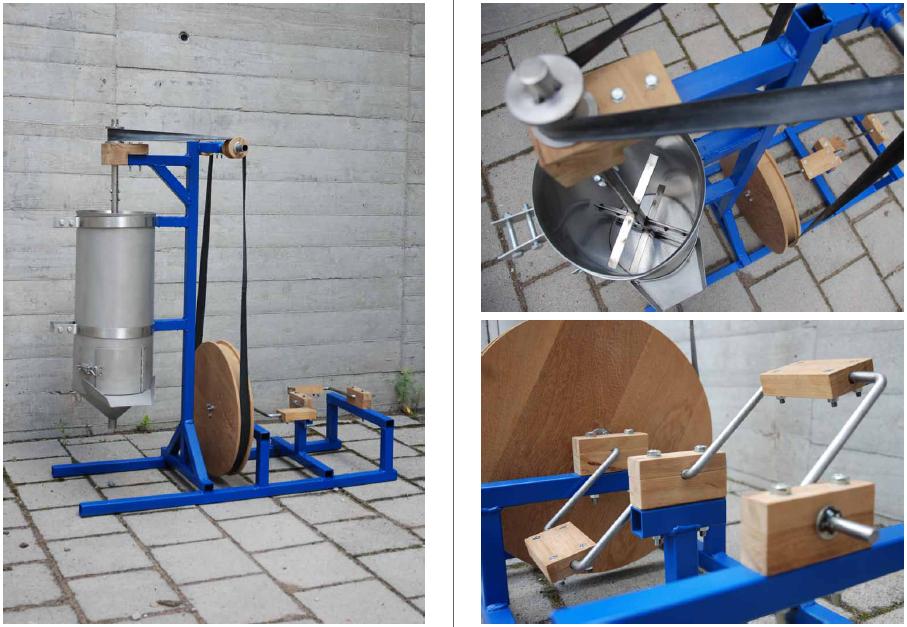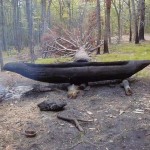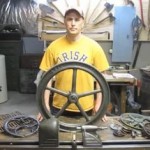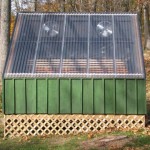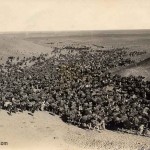What happens when two industrial design students from Sweden end up in Kenya creating a pedal powered machine for small-scale farmers who are often illiterate and speak more than 60 languages? You get a do-it-yourself design that seems to have come out of the IKEA factories – pictoral manuals included.
“Made in Kenya”, the bachelor project of Niklas Kull and Gabriella Rubin, is a textbook example of low-tech made accessible to everybody, regardless of their native tongue and language skills.
Last spring we documented the forgotten future of the pedal-powered machine, looking at both early twentieth century applications as well as the ambitious endeavours of the 1970s. These days, pedal-powered machines are often ignored when we are discussing renewable energy options – not only in the Western world but also in developing countries where other renewable energy options are often too expensive. There do exist successful local initiatives like Mayapedal in Guatemala, but these remain exceptions rather than the rule.
Knowledge transfer
One of the obstacles seems to be a lack of knowledge, and how to communicate the information needed to combat it. This does not only concern the absence of internet connections and computers; these issues can be solved relatively easily by a few isolated computers and printers combined with a sneakernet.
At least as important is the prevalence of illiteracy and semi-literacy in the developing world, and the existence of many different languages. Between 2000 and 3000 languages are spoken in Africa alone, while manuals offered by organisations such as Practical Action (and others) are understandably limited to publication in only a handful of languages.
The issue is not without relevance for the first world. Most information on Do-It-Yourself projects is written in English, while many people (for instance in Europe) have insufficient knowledge of this language, especially when it comes to understanding technical instructions.
In their project “Made in Kenya”, Lund University students Niklas Kull and Gabriella Rubin tackled these issues by avoiding words altogether.
The instructions in both the design manual and user manual of their pedal-powered juice extractor are solely visual, with the exception of a few words. They write:
“Many big companies, as for example IKEA, use simple pictograms to instruct the customer. Apart from the economic point of view, it is also strategic from a communication aspect. It is no longer necessary to have different versions for different countries and languages. The fact that many Kenyan farmers are illiterate or semi-illiterate, in combination with the varying level of English/Swahili proficiency, requires that the product can be operated and maintained with mainly pictograms and illustrations as instructions.”
Informal manufacturing industry
The students had two aims for their project: to improve the economic conditions of the local small-scale farmers, who make up three quarters of the workforce in the country, and to stimulate the local manufacturing industry. At present, Kenya lacks an industrial-scale manufacturing industry and is highly dependent on the import of goods.
The juice extractor is of a capacity and cost that would allow a small group of neighbouring farmers to invest collectively in a small production facility. To keep production costs low, ensure availability in rural areas and promote the domestic manufacturing capacity, the pedal-powered machine does not require complex components or maufacturing methods.
The design manual is aimed at the Jua Kali – the informal manufacturing sector which represents an estimated six million of the Kenyan workforce. With limited capital, modest workshop facilities and narrow access to raw materials, these self-employed blacksmiths and carpenters make handmade products – such as agricultural implements, hand tools and kitchen utensils – at a lower price than the imported goods.
“The instructions are meant to be used as a base that can be changed according to local needs, material accessibility and knowledge. If a certain material is a scarcity in an area, another one can be used. However, the cylinder, the beater and the filter, need to be made out of stainless steel. Apart from that, it is up to the jua kali. As for the wooden parts, we recommend a hard and oily wood, like for example the African iroko. Like the manual for the farmers, these instructions are also black and white to keep printing costs down.”
The student agreed to publish the manuals on Low-tech Magazine. Comments on the design of both the machine and the manuals are welcome (in the comment section below, or via email: rubin dot gabriella at gmail dot com & niklaskull at gmail dot com).
Kris De Decker (edited by Deva Lee).
———————————————————————————————————————————————-
1. THE MACHINE
———————————————————————————————————————————————-
———————————————————————————————————————————————-
———————————————————————————————————————————————-
———————————————————————————————————————————————-
———————————————————————————————————————————————-
2. THE DESIGN MANUAL
———————————————————————————————————————————————-
———————————————————————————————————————————————-
———————————————————————————————————————————————-
———————————————————————————————————————————————-
———————————————————————————————————————————————-
———————————————————————————————————————————————-
3. THE USER MANUAL
———————————————————————————————————————————————-
The text below was taken from the project description and is not included in the manual:
“Before the farmer proceeds with the actual juicing, it is important to remember to have clean hands and preferably short nails to avoid puncturing the fruit which can damage it. In addition, it is important to handle and store the fruit with care to avoid damage. The fruits are then washed carefully with clean water before the farmer prepares the machine by cleaning it. This to make sure that the juice extractor is free from dust and dirt.”
“Once this is done, the filter is placed in the bottom of cylinder. After the beaters are attached and the screws and nuts are tightened, the farmer should then control that the strap is stretched enough. If not, then it is just a matter of moving the axis to the next step and then tighten the nut. Before starting to pedal, place a clean hollowware of choice underneath the cylinder. Once the user has started pedalling and obtained an even rotation, the farmer can put the fruit into the cylinder. The juice will be filtered before it streams out into the hollowware.”
“Each time the farmer is finished with a batch of fruit, the peal and seeds need to be removed, otherwise the rotation will be disturbed. When the juicing process is finished, the stainless steel parts must be removed and cleaned thoroughly. The juice shall then be heated up to boiling point, this to prolong the life length of the juice and to ensure that all harmful bacteria is eradicated. When the fluid has reached the desired temperature, remove the foam that has emerged with a skimmer. Depending on when the juice will be consumed, lemon juice can be added to prolong shelf life. If desired sugar can be added as sweetener.”
“The juice can now be bottled in clean and tidy plastic or glass bottles. If the cleanliness of the bottles and caps can not be guaranteed, they should then be boiled in water for five minutes. Once the bottles are filled, seal the bottles and boil for ten minutes. The farmer should then let the bottles cool before labelling. It is desired that the bottles are labelled with the date of manufacture and for marketing purposes, with a brand name of choice.”
———————————————————————————————————————————————-
Related articles:
———————————————————————————————————————————————-
- Pedal powered farms and factories: the forgotten future of the stationary bicycle
- UNESCO sets up online traditional knowledge database
- How to make everything ourselves: open modular hardware
- How to tie the world together: online knotting reference books
- How to make your own low-tech vertical farm
- How to make everything yourself: online low-tech resources
- Wood gas cars and Gas bag vehicles: low-tech from World War Two
- Hand powered drilling tools and machines
- The bright future of solar powered factories
- The Museum of Old Techniques
- Truckloads of harddisks: the return of the sneakernet
- How to build a floating trash island
- The pinhole camera: low-tech photography
- Check out all our DIY-posts
